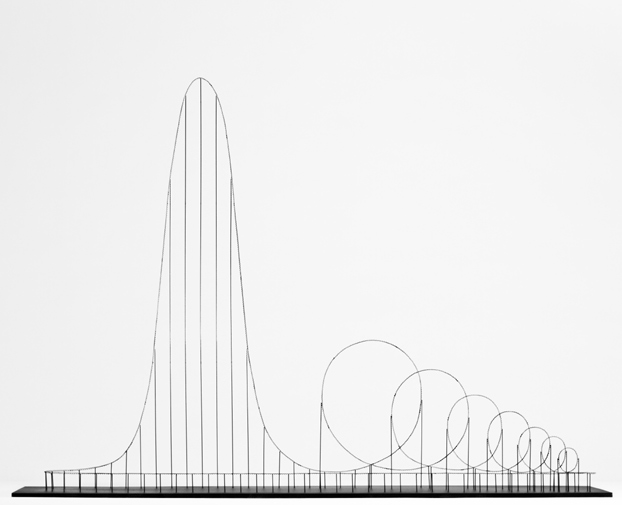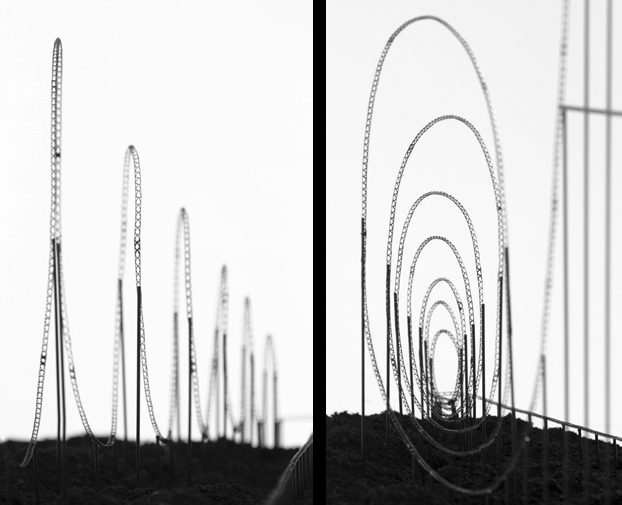
© Discovery News
Want to enjoy the ride of your life along with the last ride of your life? That's what Julijonas Urbonas envisions with his Euthanasia Coaster.
The 3-minute ride involves a long, slow, climb -- nearly a third of a mile long -- that lifts one up to a height of more than 1600 feet, followed by a massive fall and seven strategically sized and placed loops. The final descent and series of loops take all of one minute. But the 10g force from the spinning loops at 223 mph in that single minute is lethal.
According to Urbonas, the "Euthanasia Coaster is a hypothetic euthanasia machine in the form of a roller coaster, engineered to humanely -- with elegance and euphoria -- take the life of a human being."
While the thought of merging the fun (and perhaps fear) of a rollercoaster with suicide, doesn't occur to most people, but it was a no-brainer for designer Urbonas: "Briefly put, [the inspiration was] my PhD study and my long-term affair with amusement parks," he said via email to Discovery News.
Urbonas, who once worked at an amusement park in his native Lithuania, is a PhD candidate at the Royal College of Art's Design Interactions department. He considers this research in "Gravitational Aesthetics."

© Discovery News
That's because Euthanasia Coaster isn't simply meant to be about death. Urbonas sees it as both an intellectual and artful departure from the world, one that isn't about the paperwork and medical issues of the current euthanasia system. The few places where voluntary euthanasia is legal include: Belgium, Luxembourg, the Netherlands, Switzerland, and the U.S. states of Oregon and Washington.
"There is no special ritual, nor is death given special meaning except that of the legal procedures and psychological preparation. It is like death is divorced from our cultural life..." Urbonas writes. "...But if it is already legal, why not to make it more meaningful?"
How do you turn a rollercoaster ride into a "meaningful" death? Urbonas has built in a long, slow trek to the top before the first fall. In fact, of the three-minute ride, two minutes are devoted to the climb. Urbonas writes: "...The rider has a few minutes to contemplate his decision and his life in retrospect. He would find enough time to adapt to the height and get through a series of imaginary fatal falls, while realizing that the objects on the ground are getting smaller...The slightest movement of the car would trigger intense heart-beating and goosebumps and most importantly it would test your decision. Therefore the very top of the tower is an ideal place to give the very last word."
And that's when the rider is required to make the ultimate life decision: choose to continue living or push the "FALL" button and die.
So how exactly does one physically die by rollercoaster? The science behind it is pretty simple: spin fast enough and hard enough and your brain won't get enough oxygen to keep functioning. The vertical rolls of the coaster would essentially create enough centrifugal force on the body that the blood rushes down in the body instead of up to the brain.
The condition has a name: It's called
cerebral hypoxia. And it's often a side effect of other activities like deep-water diving, flying at high altitudes in an unpressurized cabin, or even exercising at high altitudes.
As for what it feels like, we can only guess, but Urbonas' research has led him to come to the following conclusions:
"...if you are lucky, or rather g-force-resistant enough to be awake [after the initial fall], your vision may blur, lose color (greyout) and peripheral sight (tunnel vision), even disappear completely (blackout) together with hearing. Eventually, this experience -- accompanied with disorientation, anxiety, confusion, and, most importantly, euphoria -- is crowned with GLOC (G-force induced Loss Of Consciousness), during which the body is completely limp and vivid bizarre dreams occur such as being in a maze and unable to get out, or floating in a white space, not knowing who you are, why you are here, etc."
According to Urbonas, there's no documented evidence that guarantees how long or how much force it takes to die via roller-coaster-induced cerebral hypoxia. But, given what is known about oxygen deprivation to the brain, Urbonas can make an educated guess: "The first or second loop might already kill the rider. But the following ones will do the job for sure. If you think in terms of engineering, the coaster incorporates a seven-fold redundancy," he wrote via e-mail to Discovery News.
While you would almost certainly die, Urbonas also admits that there may be ways to "hack" the Euthanasia Coaster and survive. Potentially, quadriplegics might survive the ride since their bodies lack substantial volume in the lower extremities to pool the blood.
Also, an aeronautic engineer who happened upon one of Urbonas' recent exhibitions suggested that if a rider were to wear the anti-g-trousers that prevent pilots from blackout and fainting, it could become the ultimate thrill ride -- literally, cheating death.
For now though, the Euthanasia Coaster remains at a 1:500 scale model. Urbonas doesn't see it being built in full until "...the future where the politics of technologies are much less centralized and more creative, diversified and democratic."
You can see a full interview with Urbonas and video of the scale-model Euthanasia Coaster below.
...Necromancer. He and Ray Kurzweil should become fast friends. To each their own, but with regards to decentralization of the policies of technologies, I don't think the construction of relatively expensive and elaborate execution devices is really a positive step in any kind of model of civilization. While the idea has a certain "cleverness" in terms of raw physics appeal, it is still a device designed to kill, and the creator's non-chalant attitude towards its nature, purpose and function is very strange and unnatural to me.
Cleverness and wisdom are not the same thing. I should think the establishment will be watching this young man's career with great anticipation - he will make a wonderful "State Minister of Entertainment".